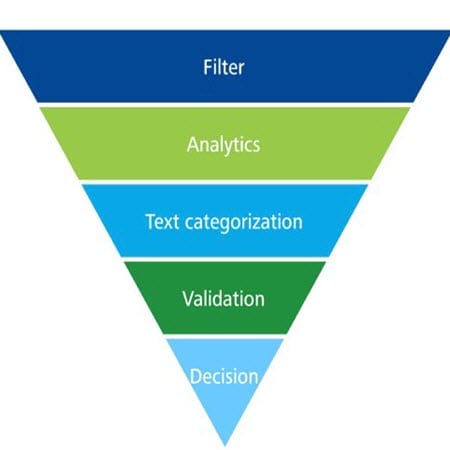Dynamic Review has been saved

Perspectives
Dynamic Review
Document review in a new perspective
As the volume of electronically stored information increases at an exponential rate, many organizations are looking for new ways to manage document review and reign in escalating costs. Meanwhile, advanced analytics techniques such as predictive coding are opening the door to new opportunities for corporate legal departments, government agencies, and outside counsel looking to make sense of this growing mountain of information.
How it works
Analytics capabilities allow organizations to move beyond traditional, linear review methodologies, gaining more insights in near-real-time to inform timely decisions. Dynamic Review can do just that by using a multi-layer approach to document review, powered by text categorization that can provide users with a deeper understanding of the makeup of a review population. Just as important, this approach offers validation which helps support transparency and defensibility through supplemental insights. The result? A more efficient workflow that can reveal insights on the growing volume and velocity of review data sets.
Deloitte’s Dynamic Review can provide a host of advantages to organizations looking to make smarter decisions using data driven insights, including:
- Reduce the number of documents requiring human review—by up to 90 percent in some cases
- Reduce document review cost

Our approach
Deloitte uses a multi-layered approach, powered by text categorization and analytics, to support document review decisions.
Filtering methods, such as scoping the initial collection deNIST processes, keyword search, date search, and deduplication, are used initially to cull the document set.
Analytics techniques, such as near duplicate identification, email threading, clustering, and concept searching are used to assess and strategize how to reduce and prioritize the review population.
Text categorization is then implemented in conjunction with traditional workflows to provide you with a deeper understanding of the makeup of the review population. Each document is scored to indicate which are likely responsive or not, privileged or hot.
Validation, the process of measuring how text categorization is performing, provides both useful benchmark information as well as insights into where supplemental analytics may be useful to inform review decisions.
Review decisions can be made using intelligence gained about the review population to: further organize and prioritize review, enhance quality control, further reduce the review population, and allocate resources more efficiently.
More methodology detail
Learn more about how Dynamic Review works. View or download the brochure, or reach out to us.
Recommendations
2024 Global Corporate Divestiture Survey
5 bold steps to becoming ‘divestiture-ready’
Deciding how and when to preserve corporate data
Practical tips for managing data preservation



